
Crawl Space Encapsulation
Crawl Space Encapsulation
Approximately 20% of newly constructed homes in the United States have underground spaces (also known as crawl spaces). The HVAC, electrical, plumbing, gas lines, and irrigation systems in your home are all housed in these space areas. However, mold and mildew are common problems in homes with open, ventilated underground spaces. These problems can affect and reduce the HVAC system's efficiency and lifespan. Crawl space repair can be expensive, and water damage may make it even more costly. So, experts advocate encapsulation to avoid these crawl encapsulation problems.
What Is Crawl Space Encapsulation?
Crawl space encapsulation refers to the installation of a heavy-duty moisture barrier, sealed vents, insulated walls, and a crawl space dehumidifier in your crawl space. The best way to encapsulate a crawl space is to seal it off. You can use a dehumidifier to control the humidity in the room once you've sealed it off.
What Is The Difference Between Crawl Space Encapsulation And Insulation?
The terms Crawl space encapsulation and crawl space insulation are sometimes used interchangeably by homeowners. However, the two are used for relatively different purposes. Encapsulating the crawl area is an excellent solution to issues such as ground moisture and damp air. Crawl space insulation, on the other hand, is best used to combat cold flooring.
What is required by code?
Here in central Tennessee new homes have two options to meet codes. The first now requires a vapor barrier on the ground of a vented crawl space in addition to insulation (R-19) in the floor joists. A vapor barrier is plastic laid directly on the ground to limit moisture from rising. The second option is a “conditioned” crawl space. This means, no air flow. This can be achieved by encapsulation.
Tips Encapsulating Your Crawl Space
It's best to do everything right when you're spending thousands of dollars on a home improvement project. When encapsulating your crawl space, here are some things to avoid.
Do not Encapsulate Unless You've Sealed the Space
Encapsulating your crawl space will help keep it dry, but huge air spaces will allow outside air into the crawl space, making it ineffective. Crawl spaces must be sealed off from outside sources of air so that a dehumidifier can work properly to remove excess moisture from the crawl space.
Proper Drainage Systems Are Crucial
Drainage systems are often overlooked by homeowners who believe that encapsulation would keep water out of their crawl spaces. This is a mistake since it does not stop water from entering or flooding under dwellings. It is best to establish a water drainage system to keep water from resting on your property.
Should Fiberglass Be Used in Crawl Spaces?
Fiberglass can cause problems in a poorly kept vented crawl space. Fiberglass does not cause mold but acts a conduit. It will hold moisture and then transfer it to the wooden joists where moisture can cause growth to occur. In an encapsulated, conditioned space or one with a suitable vapor barrier the fiberglass will perform well and keep the floors warm. Moisture is the problem, not the fiberglass.
Get a professional To Do the Job
DIY home improvement projects can be both interesting and cost-effective for many homeowners. Crawl Space Encapsulation, on the other hand, is a project best left to the professionals. Crawlspace encapsulation can be time-consuming, difficult, and expensive if you don't have the skill and experience.
The Benefits of Encapsulation
- It prevents mold and mildew
- You get better air quality
- You can prevent structural damage
Spray Foam in Crawl Spaces
We like to use 2.0 lb Closed Cell spray foam in crawl spaces. During encapsulations we use the foam to adhere the plastic to the block walls. The foam is completely air and moisture impermeable. It is the best solution without a doubt.
We also use closed cell foam in vented crawl spaces. We spray the subfloor with 2” of the foam. This far exceeds the insulation requirements and eliminates any moisture, air or odor from leaking into the living space from below. As an added benefit the closed cell foam actually increases the rigidity of whatever it adheres to and can often eliminate creaks.
Do You Want a Professional Crawl Space Installation in your home? Let's Serve You!
Contact Koala Insulation now for all of your residential insulation needs. We provide top-notch for our clients. We are pleased to serve clients from Nashville, Brentwood, Franklin, Belle Meade, Old Hickory, Madison, Green Hills, Smyrna, Hermitage, and La Vergne. Call us to get a quote.
Ready to book your free insulation evaluation?
We have 3 convienant ways for you to get in touch
We Provide Insulation Services to the Following Nashville Areas
Hermitage, Madison, Mount Juliet, Old Hickory, Nashville, Whites Creek, Lascassas, Murfreesboro, Rockvale, Antioch, La Vergne, Nolensville, Smyrna, Arrington, Brentwood, College Grove, Eagleville, Franklin, Thompsons Station
Counties Served
Davidson County, Wilson County, Rutherford County, Williamson County
Zip Code
37085, 37127, 37128, 37129, 37130, 37153, 37204, 37205, 37211, 37215, 37217, 37220, 37221, 37189, 37201, 37203, 37206, 37207, 37208, 37209, 37210, 37212, 37213, 37218, 37219, 37228, 37232, 37234, 37240, 37243, 37246, 37076, 37115, 37122, 37138, 37214, 37216, 37014, 37027, 37046, 37060, 37064, 37067, 37069, 37179, 37013, 37086, 37089, 37135, 37167

